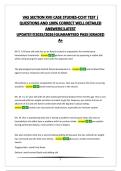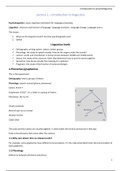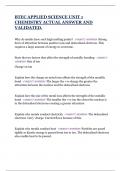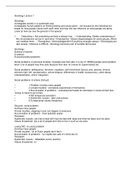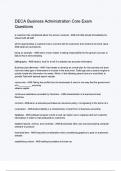Summary of Introduction to Sociology -
Frank Tubergen
David van Lieshout. Student pre-master Sociology. University of
Tilburg
Reading scheme
- Week 1: 1,2
- Week 2: 3,4
- Week 4: 9, 10
- Week 5: 6,8
- Week 6: 5,12
- Week 7: 7,11,13
Summarized until page 564 in the pdf doc
Inhoudsopgave
David van Lieshout. Student pre-master Sociology. University of Tilburg.................................1
Part 1 Thinking like a sociologist..................................................................................................5
1 Questions.............................................................................................................................. 5
1.1 The sociological perspective...........................................................................................5
1.2 Social problems.............................................................................................................. 7
1.3 Three aims of sociology..................................................................................................8
1.4 Three types of sociological questions.............................................................................9
1.5 The art of asking good sociological questions.................................................................9
1.6 Sociology and common sense......................................................................................11
1.7 Sociology as cumulative science..................................................................................12
2 Theories.............................................................................................................................. 13
2.1 Birth month and success in sports................................................................................13
2.2 Theories and explanations............................................................................................13
2.3 What are useful sociological theories............................................................................14
2.4 Durkheim’s theory of suicide.........................................................................................15
2.5 Concepts....................................................................................................................... 16
2.6 Causality....................................................................................................................... 17
1
, S2
2.7 Conceptual models.......................................................................................................18
2.8 Formal models.............................................................................................................. 20
3 Methods.............................................................................................................................. 20
3.1 Is your smartphone making you stupid..........................................................................20
3.2 Measurement quality.....................................................................................................22
3.3 External validity............................................................................................................. 25
3.4 Internal validity.............................................................................................................. 26
3.5 Exploratory research.....................................................................................................26
3.6 Qualitative and quantitative methods............................................................................27
3.7 Case study research.....................................................................................................27
3.8 Administrative research................................................................................................28
3.9 Survey research............................................................................................................ 28
3.10 Big data research........................................................................................................28
3.11 Experimental research................................................................................................29
3.12 Replication.................................................................................................................. 30
4 Perspectives........................................................................................................................ 30
4.1 The origins of sociological perspectives........................................................................30
4.2 Sociological themes and topics.....................................................................................31
4.3 Causal explaining or subjective understanding?...........................................................34
4.4 Multilevel framework.....................................................................................................34
Part 2 Culture............................................................................................................................. 34
5 Opinions.............................................................................................................................. 35
5.1 Why is harry potter popular?.........................................................................................35
5.2 Self-fulfilling prophecy...................................................................................................35
5.3 Conformity.................................................................................................................... 36
5.4 Informational and normative social influence................................................................37
5.5 Social learning theory...................................................................................................38
5.6 Popularity of cultural products.......................................................................................39
5.7 Diffusion of innovations.................................................................................................40
6 Norms.................................................................................................................................. 41
6.4 Internalized norms........................................................................................................ 42
6.5 Legal norms.................................................................................................................. 42
6.6 Why do norms emerge?................................................................................................42
2
, S3
6.7 Cultural maladaptation and norm change.....................................................................43
6.8 The dynamics of group distinction.................................................................................44
Part 3 Social relations................................................................................................................ 44
7 Networks............................................................................................................................. 44
7.1 Friendship paradox.......................................................................................................44
7.2 Personal networks........................................................................................................ 45
7.3 Network size and hubs..................................................................................................46
7.4 Network density and transitivity.....................................................................................46
7.5 Small world phenomenon.............................................................................................47
7.6 Network change: loss-of-community?...........................................................................47
7.7 Networks and social cohesion.......................................................................................47
7.8 Networks and social capital...........................................................................................48
8 Groups................................................................................................................................ 48
8.1 Groups unite and divide................................................................................................48
8.2 Group segregation........................................................................................................49
8.3 The causes of group segregation..................................................................................49
8.4 In-group favoritism........................................................................................................50
8.5 Social context and in-group favoritism..........................................................................50
8.6 Group threat theory.......................................................................................................51
Part 4 Inequality......................................................................................................................... 51
9 Stratification and mobility.....................................................................................................51
9.1 What makes you happy?..............................................................................................51
9.2 Social class and status.................................................................................................51
9.3 Income and wealth........................................................................................................52
9.4 Long-term changes in stratification...............................................................................52
9.5 Social mobility............................................................................................................... 53
9.6 Ascription and achievement (Blau-Duncan)..................................................................53
9.7 Modernization and mobility theory................................................................................54
9.8 Cultural reproduction theory..........................................................................................55
9.9 The Great Gatsby Curve...............................................................................................56
10 Resources......................................................................................................................... 57
10.1 Human capital............................................................................................................. 57
10.2 Social capital............................................................................................................... 58
3
, S4
10.3 Group affiliation and discrimination.............................................................................60
10.4 Inequality of outcomes, opportunities and returns.......................................................61
10.5 Gender inequality........................................................................................................61
Part 5 Topics.............................................................................................................................. 62
11 Immigration and integration...............................................................................................62
11.1 Immigration and integration: a social problem?...........................................................62
11.2 International migration................................................................................................62
11.3 International migration................................................................................................63
11.4 Integration: changes over time?..................................................................................63
11.5 Integration: social context effects?..............................................................................64
11.6 Case study: culture of honor.......................................................................................64
11.7 Integration: selective or spillover effects?...................................................................64
11.8 The dynamics of residential segregation.....................................................................65
12 Modernization.................................................................................................................... 65
12.1 Is the world getting worse?.........................................................................................65
12.2 Wealth and health.......................................................................................................65
12.3 Peace and safety........................................................................................................66
12.4 Rationalization............................................................................................................ 66
12.5 Technological progress...............................................................................................67
12.6 Scientization............................................................................................................... 68
12.7 McDonaldization......................................................................................................... 68
12.8 Value change.............................................................................................................. 68
12.9 Population change......................................................................................................70
12.10 The dynamics of modernization................................................................................71
13 Religion............................................................................................................................. 73
13.1..................................................................................................................................... 73
References made in text............................................................................................................ 73
4
Frank Tubergen
David van Lieshout. Student pre-master Sociology. University of
Tilburg
Reading scheme
- Week 1: 1,2
- Week 2: 3,4
- Week 4: 9, 10
- Week 5: 6,8
- Week 6: 5,12
- Week 7: 7,11,13
Summarized until page 564 in the pdf doc
Inhoudsopgave
David van Lieshout. Student pre-master Sociology. University of Tilburg.................................1
Part 1 Thinking like a sociologist..................................................................................................5
1 Questions.............................................................................................................................. 5
1.1 The sociological perspective...........................................................................................5
1.2 Social problems.............................................................................................................. 7
1.3 Three aims of sociology..................................................................................................8
1.4 Three types of sociological questions.............................................................................9
1.5 The art of asking good sociological questions.................................................................9
1.6 Sociology and common sense......................................................................................11
1.7 Sociology as cumulative science..................................................................................12
2 Theories.............................................................................................................................. 13
2.1 Birth month and success in sports................................................................................13
2.2 Theories and explanations............................................................................................13
2.3 What are useful sociological theories............................................................................14
2.4 Durkheim’s theory of suicide.........................................................................................15
2.5 Concepts....................................................................................................................... 16
2.6 Causality....................................................................................................................... 17
1
, S2
2.7 Conceptual models.......................................................................................................18
2.8 Formal models.............................................................................................................. 20
3 Methods.............................................................................................................................. 20
3.1 Is your smartphone making you stupid..........................................................................20
3.2 Measurement quality.....................................................................................................22
3.3 External validity............................................................................................................. 25
3.4 Internal validity.............................................................................................................. 26
3.5 Exploratory research.....................................................................................................26
3.6 Qualitative and quantitative methods............................................................................27
3.7 Case study research.....................................................................................................27
3.8 Administrative research................................................................................................28
3.9 Survey research............................................................................................................ 28
3.10 Big data research........................................................................................................28
3.11 Experimental research................................................................................................29
3.12 Replication.................................................................................................................. 30
4 Perspectives........................................................................................................................ 30
4.1 The origins of sociological perspectives........................................................................30
4.2 Sociological themes and topics.....................................................................................31
4.3 Causal explaining or subjective understanding?...........................................................34
4.4 Multilevel framework.....................................................................................................34
Part 2 Culture............................................................................................................................. 34
5 Opinions.............................................................................................................................. 35
5.1 Why is harry potter popular?.........................................................................................35
5.2 Self-fulfilling prophecy...................................................................................................35
5.3 Conformity.................................................................................................................... 36
5.4 Informational and normative social influence................................................................37
5.5 Social learning theory...................................................................................................38
5.6 Popularity of cultural products.......................................................................................39
5.7 Diffusion of innovations.................................................................................................40
6 Norms.................................................................................................................................. 41
6.4 Internalized norms........................................................................................................ 42
6.5 Legal norms.................................................................................................................. 42
6.6 Why do norms emerge?................................................................................................42
2
, S3
6.7 Cultural maladaptation and norm change.....................................................................43
6.8 The dynamics of group distinction.................................................................................44
Part 3 Social relations................................................................................................................ 44
7 Networks............................................................................................................................. 44
7.1 Friendship paradox.......................................................................................................44
7.2 Personal networks........................................................................................................ 45
7.3 Network size and hubs..................................................................................................46
7.4 Network density and transitivity.....................................................................................46
7.5 Small world phenomenon.............................................................................................47
7.6 Network change: loss-of-community?...........................................................................47
7.7 Networks and social cohesion.......................................................................................47
7.8 Networks and social capital...........................................................................................48
8 Groups................................................................................................................................ 48
8.1 Groups unite and divide................................................................................................48
8.2 Group segregation........................................................................................................49
8.3 The causes of group segregation..................................................................................49
8.4 In-group favoritism........................................................................................................50
8.5 Social context and in-group favoritism..........................................................................50
8.6 Group threat theory.......................................................................................................51
Part 4 Inequality......................................................................................................................... 51
9 Stratification and mobility.....................................................................................................51
9.1 What makes you happy?..............................................................................................51
9.2 Social class and status.................................................................................................51
9.3 Income and wealth........................................................................................................52
9.4 Long-term changes in stratification...............................................................................52
9.5 Social mobility............................................................................................................... 53
9.6 Ascription and achievement (Blau-Duncan)..................................................................53
9.7 Modernization and mobility theory................................................................................54
9.8 Cultural reproduction theory..........................................................................................55
9.9 The Great Gatsby Curve...............................................................................................56
10 Resources......................................................................................................................... 57
10.1 Human capital............................................................................................................. 57
10.2 Social capital............................................................................................................... 58
3
, S4
10.3 Group affiliation and discrimination.............................................................................60
10.4 Inequality of outcomes, opportunities and returns.......................................................61
10.5 Gender inequality........................................................................................................61
Part 5 Topics.............................................................................................................................. 62
11 Immigration and integration...............................................................................................62
11.1 Immigration and integration: a social problem?...........................................................62
11.2 International migration................................................................................................62
11.3 International migration................................................................................................63
11.4 Integration: changes over time?..................................................................................63
11.5 Integration: social context effects?..............................................................................64
11.6 Case study: culture of honor.......................................................................................64
11.7 Integration: selective or spillover effects?...................................................................64
11.8 The dynamics of residential segregation.....................................................................65
12 Modernization.................................................................................................................... 65
12.1 Is the world getting worse?.........................................................................................65
12.2 Wealth and health.......................................................................................................65
12.3 Peace and safety........................................................................................................66
12.4 Rationalization............................................................................................................ 66
12.5 Technological progress...............................................................................................67
12.6 Scientization............................................................................................................... 68
12.7 McDonaldization......................................................................................................... 68
12.8 Value change.............................................................................................................. 68
12.9 Population change......................................................................................................70
12.10 The dynamics of modernization................................................................................71
13 Religion............................................................................................................................. 73
13.1..................................................................................................................................... 73
References made in text............................................................................................................ 73
4


